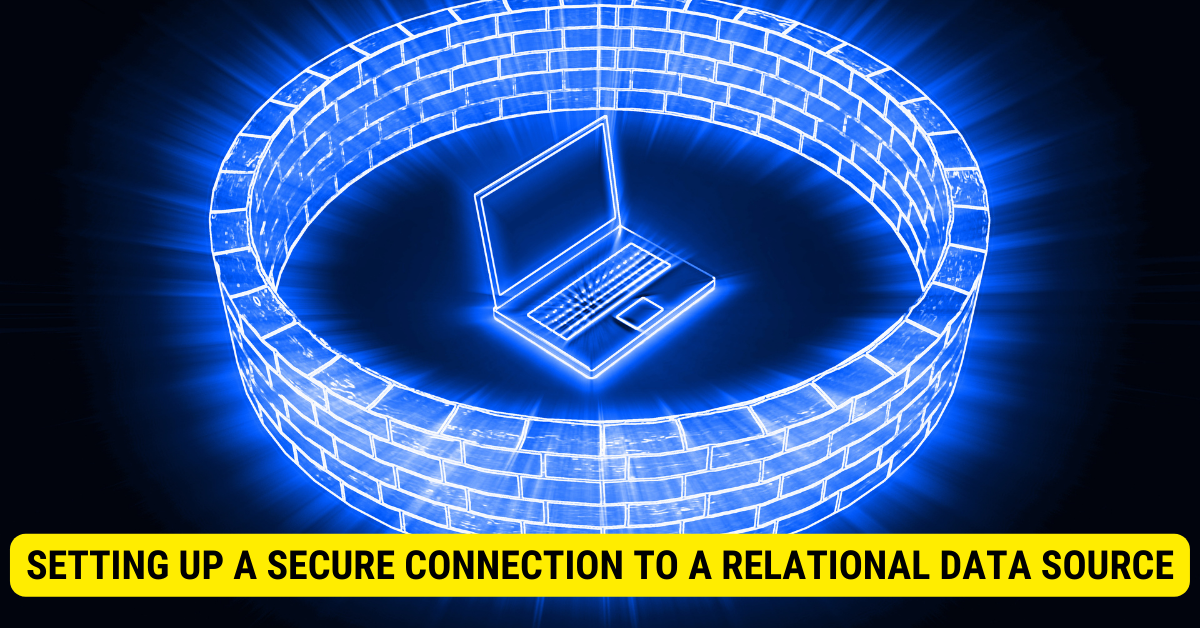Yes, it is true that the Data Tab is Used for Secure Connection to Relational Data Source
Various tools and tabs’ functionalities are paramount in data management and security. One such tool is the data tab. The question arises, “The data tab is used for setting up a secure connection to a relational data source. True or false?” We need to delve deeper into the topic to get to the bottom of this.
Understanding the Data Tab
The data tab serves as the backbone of most data management systems. While it is easy to underestimate its importance, the functionalities it offers are undeniable.
This tool lets data managers and technicians monitor and manipulate the data hosted within their systems. It is crucial for database administration tasks such as data extraction, updating records, and managing data sources.
With the increasing complexity of data management, the data tab has become an indispensable tool in the field. It provides a centralized platform for data professionals to streamline their tasks and ensure the smooth operation of their systems.
The Role of the Data Tab in Data Management
The data tab has a unique role in data management. More than just a computing interface, it is a critical strategy tool. It combines data from numerous sources, providing an all-encompassing data management solution.
By consolidating data from various sources, the data tab enables data managers to gain a comprehensive view of their organization’s information. This holistic approach allows for better decision-making and improved data analysis.
Furthermore, the data tab is crucial in data governance and compliance. It ensures that data is stored, accessed, and manipulated by industry regulations and internal policies. This helps organizations maintain data integrity and protect sensitive information.
Moreover, the data tab serves as a collaboration hub for data teams. It allows multiple users to access and work on the same dataset simultaneously, fostering collaboration and enhancing productivity.
Key Features of the Data Tab
The data tab’s efficiency and ease can be attributed to its features. It is designed with precision and versatility, catering to the diverse needs of data management.
One of the data tab’s key features is its support for various data manipulation languages. This flexibility allows database administrators to execute commands seamlessly, regardless of the preferred language or syntax.
Additionally, the data tab’s user-friendly interface is designed to boost ease of navigation and data accessibility. It provides intuitive tools and visualizations, making it easier for users to interact with and understand the data.
Another notable feature of the data tab is its robust data integration capabilities. It enables seamless integration with external systems and data sources, allowing real-time data updates and synchronization.
Furthermore, the data tab offers advanced data profiling and quality management features. These tools help identify data inconsistencies, anomalies, and errors, ensuring that the data within the system is accurate and reliable.
In conclusion, the data tab is crucial to any data management system. It plays a vital role in data administration, strategy, and collaboration. Its diverse features and capabilities empower data professionals to manage and utilize their organization’s assets effectively.
Setting Up a Secure Connection to a Relational Data Source

Advancements in data technology have brought about relational data sources. These are databases styled to recognize the relations between stored information items, enabling a flexible model for data manipulation.
To interact with these sources securely, a connection needs to be established. This process often confirms the initial assertion about the data tab.
Setting up a secure connection involves several steps that ensure the safety and integrity of your data.
Steps to Establish a Secure Connection
- The First Step Usually Involves Accessing The Data Tab On Your Data Management System Interface.
When accessing the data tab, you gain access to the necessary tools and options to establish a secure connection to your relational data source. This tab is typically in your data management system’s settings or configuration section.
- Next, A New Connection Command Is Initiated.
You are instructing the system to establish a fresh and secure connection to your relational data source by initiating a new connection command. This ensures that any previous connections are terminated, reducing the risk of unauthorized access to your data.
- The Details Of The Relational Data Source Are Filled In As Requested. This Includes The Hostname, Username, And Password.
When filling in the details of the relational data source, it is important to provide accurate information to ensure a successful and secure connection. The hostname refers to the server’s address where the data source is located. The username and password are used to authenticate and verify your access to the data source.
- Lastly, The Connection Is Tested And Saved If Successful.
After filling in the necessary details, it is crucial to test the connection to ensure its security and reliability. The system will attempt to establish a connection using the provided information. If the connection is successful, it is saved for future use, allowing you to access the relational data source whenever needed easily.
Undertaking these steps with care ensures a safe conduit between your system and the relational data source. By establishing a secure connection, you protect your data from unauthorized access and maintain the confidentiality and integrity of your information.
Importance of Secure Connections in Data Management

Security is an undeniable priority in data management. Breaches can lead to drastic losses, both in terms of resources and trust. Therefore, ensuring a secure connection to your data sources is not optional but a necessity.
Secure connections prevent unauthorized access, upholding data integrity and confidentiality. They also facilitate smooth data transfers, optimizing overall data management.
By establishing secure connections, you can trust that your data is protected and that your data management efforts are conducted with the highest level of security.
The Relationship Between the Data Tab and Relational Data Sources
One cannot discuss data tabs without acknowledging relational data sources. The two are intertwined in functionality and purpose; they complement each other in their roles.
A relational data source is best utilized through a well-structured tool like the data tab. Conversely, the data tab thrives on the robust dynamics of relational data sources.
It is important to delve into how it interacts with these sources to fully understand the relationship between the data tab and relational data sources.
How the Data Tab Interacts with Relational Data Sources?

The data tab serves as an interface between system users and the relational data source. It receives user commands, processes them, and implements the outcomes within the data source.
For example, when users want to retrieve specific data from a relational data source, they input the necessary commands into the data tab. The data tab then communicates with the relational data source, retrieves the requested data, and presents it to the user in a structured and organized manner.
These interactions lead to a symbiotic relationship where commands executed using the data tab reflect in the relational data source. Any updates made through the data tab are immediately reflected in the underlying data source, ensuring consistency and accuracy.
Furthermore, the data tab enables users to manipulate and modify data within the relational data source. Users can add, delete, or update data entries through the intuitive interface provided by the data tab.
The data tab bridges users and relational data sources, facilitating seamless interactions and ensuring efficient data management.
Benefits of Using the Data Tab with Relational Data Sources
The data tab offers undeniable benefits when integrated with a relational data source. It simplifies the task of managing complex sets of data by offering streamlined, organized interfaces.
With the data tab, users can easily navigate through large volumes of data, filter and sort information, and perform advanced searches. This saves time and enhances productivity by providing users with a clear overview of the data.
Another significant advantage of using the data tab with relational data sources is its enhanced data accuracy. The underlying relational data source immediately reflects the changes as updates are made through the data tab. This real-time synchronization ensures that the data remains consistent and up-to-date.
Additionally, the data tab facilitates quick retrievals by mapping the relations between different data sets within the relational data source. This allows users to access related data without requiring complex queries or manual cross-referencing.
Moreover, the data tab also offers features such as data visualization and reporting, enabling users to gain valuable insights from the relational data source. The data tab empowers users to make informed decisions based on the information at hand by presenting data in a visually appealing and understandable format.
In conclusion, the data tab and relational data sources have a symbiotic relationship that greatly enhances data management and analysis. The data tab is an interface facilitating seamless user interactions and relational data sources. The data tab simplifies data management and ensures data accuracy through its streamlined interfaces and real-time synchronization. Its ability to map relations and provide data visualization further enhances the benefits of using the data tab with relational data sources.
Evaluating the Statement: The Data Tab is Used for Setting Up a Secure Connection
It’s time to answer the initially posed question. By examining the role of the data tab and understanding its relationship with relational data sources, we can effectively evaluate its connection setup.
The statement seems true in light of the information discussed; the data tab is used for setting up a secure connection.
Analyzing the Truth of the Statement
Given the steps involved in establishing a secure connection, it is clear this procedure takes place within the data tab. Whether initiating a new connection or adjusting pre-existing settings, the data tab’s interface facilitates these processes.
This proves the factual nature of the statement and reaffirms the data tab’s purpose in data management systems.
Common Misconceptions about the Data Tab’s Functionality
Despite this clarity, some misconceptions persist regarding the data tab’s role. A common misconception is that the data tab is solely a data visualization tool, undermining its utility in data management.
However, as clearly explained, the data tab goes beyond simple visualization. Its functionality includes vital tasks such as securing connections to relational data sources.
Key Takeaways
- The data tab facilitates the connection setup to relational data sources.
- Secure connections are vital for protecting sensitive data during transfers.
- Relational data sources can include databases like SQL, Oracle, or PostgreSQL.
- Proper configuration is essential for ensuring the security of the connection.
- Always monitor and test the connection for potential vulnerabilities.
FAQs
Q: What are relational data sources?
A: They are databases using structured query language (SQL) to manage data.
Q: Why is a secure connection necessary?
A: To ensure data privacy and protection from potential breaches.
Q: Can I connect to multiple data sources using the data tab?
A: You can connect to multiple data sources depending on the software.
Q: What type of security protocols are usually employed?
A: Protocols like SSL/TLS are often used to ensure a secure connection.
Q: How do I know my connection is secure?
A: Ensure that security certificates are valid and test the connection for vulnerabilities.
Conclusion
The data tab plays a pivotal role in modern data management systems. As the detailed exploration suggests, the data tab is instrumental in securing a secure connection to relational data sources. This not only guarantees the safeguarding of data but also enhances the ease of data transfer and management. Recognizing and utilizing the data tab’s functionality is fundamental for comprehensive and secure data management.
